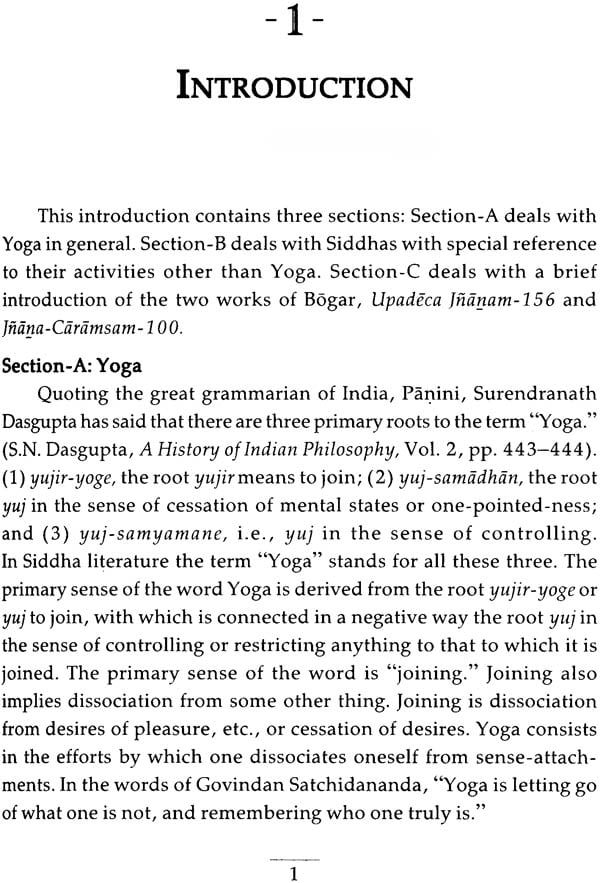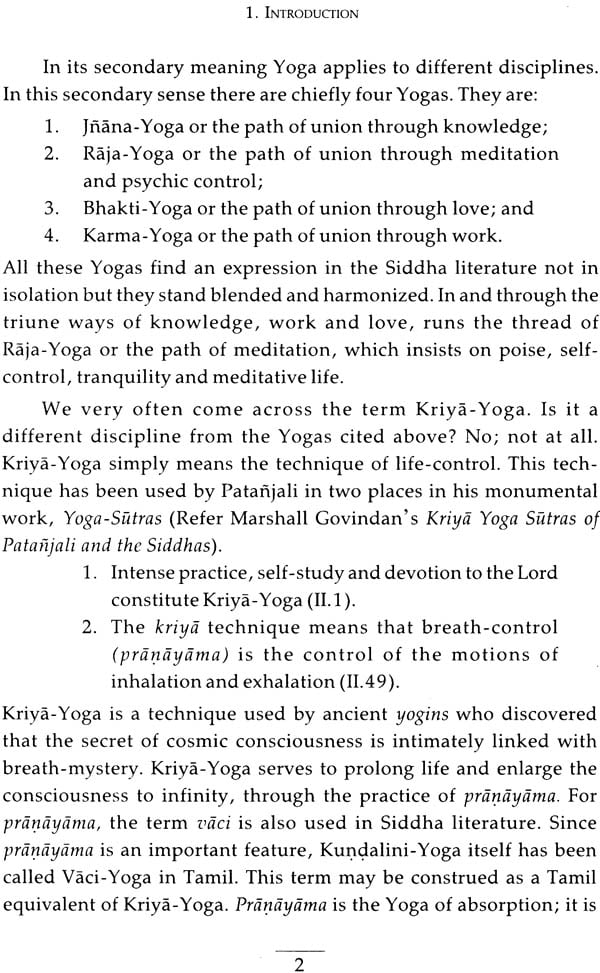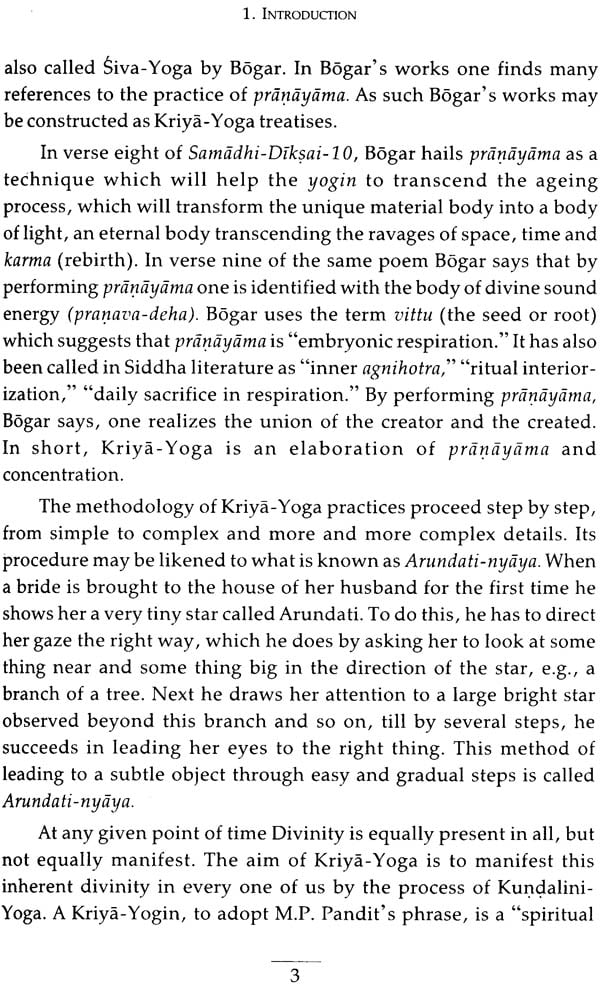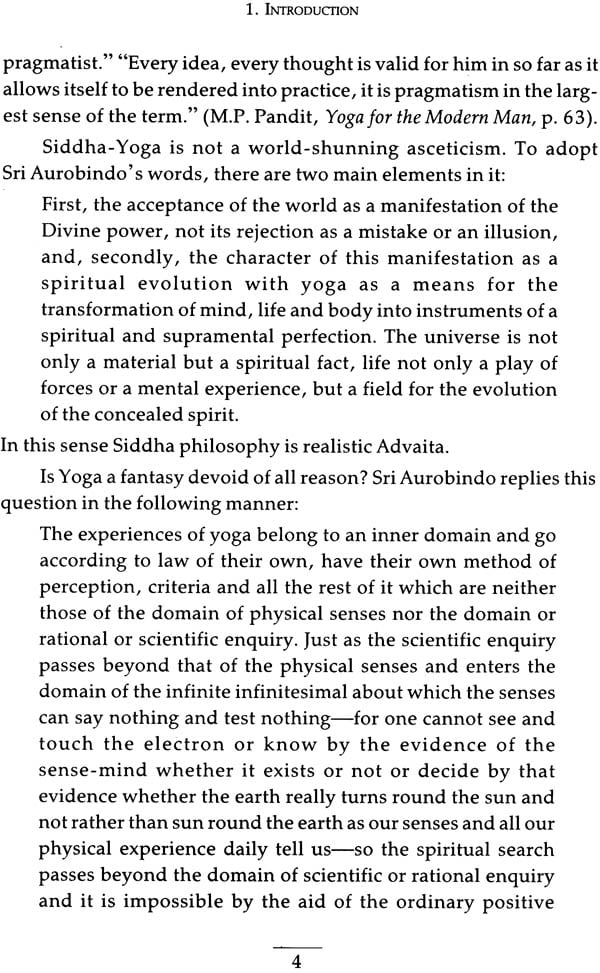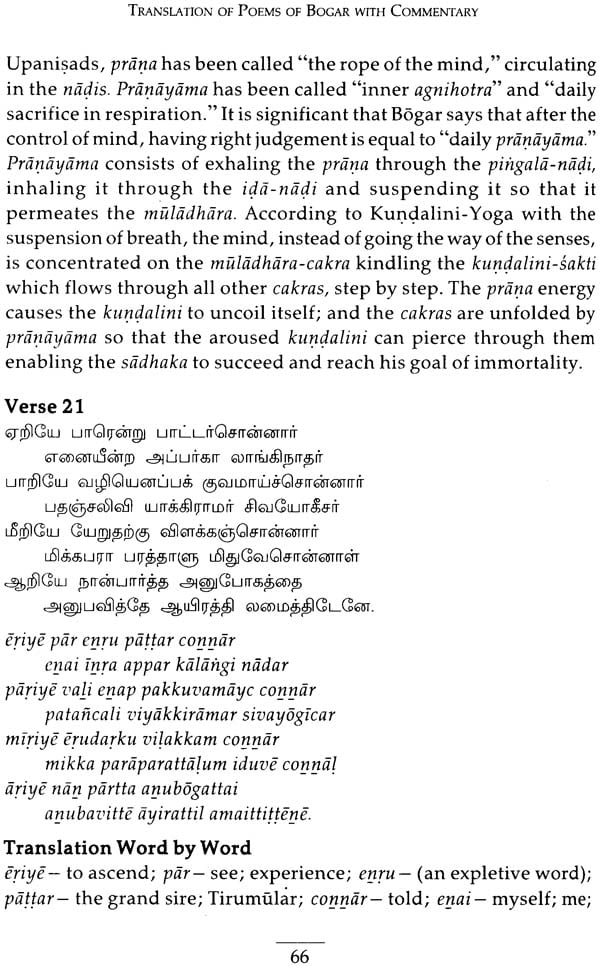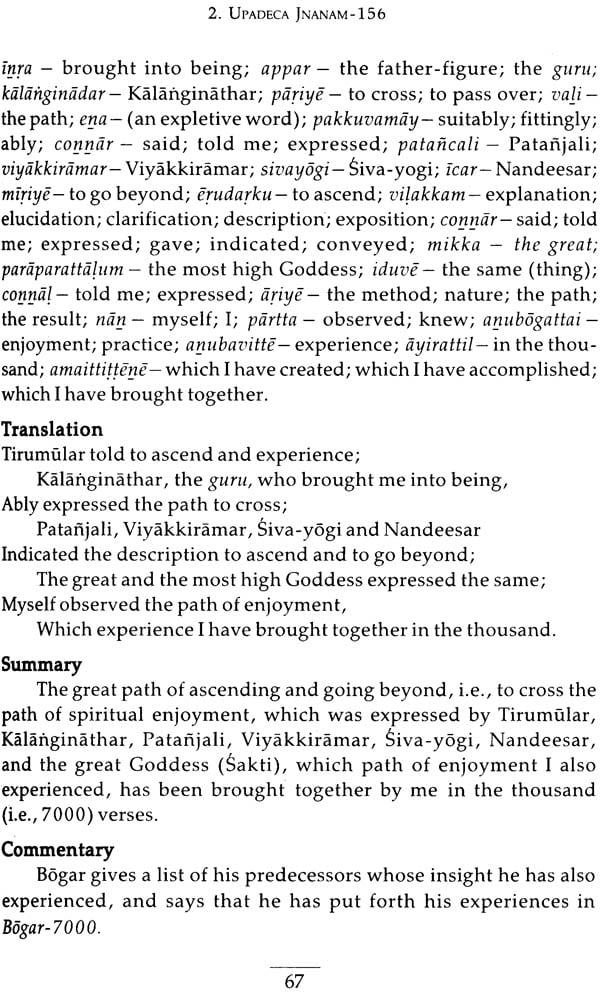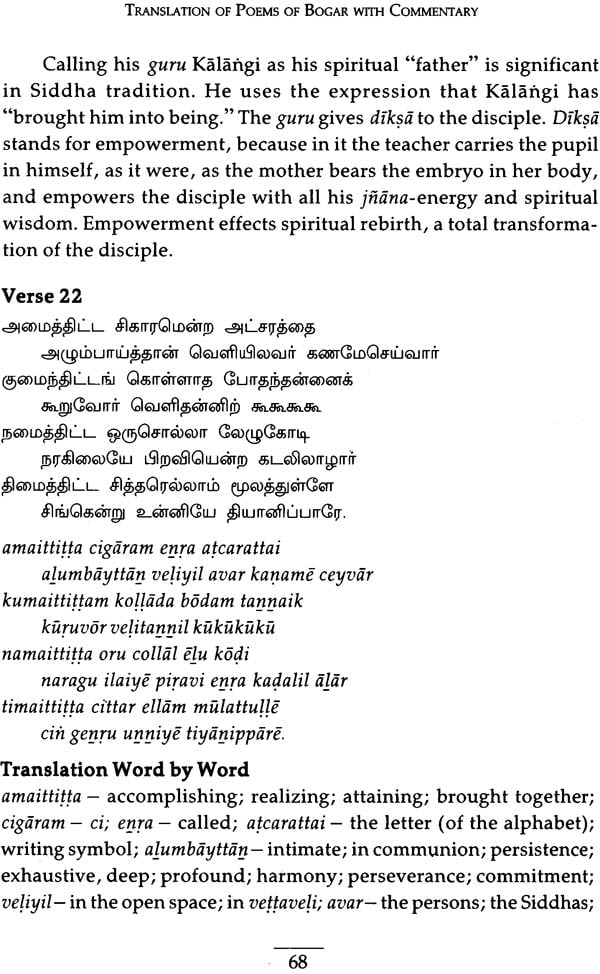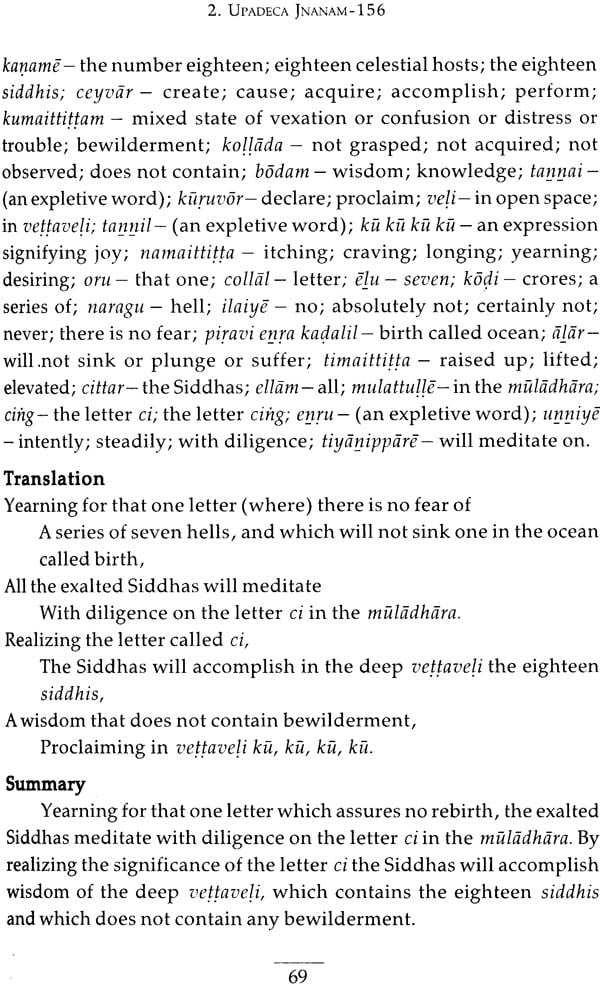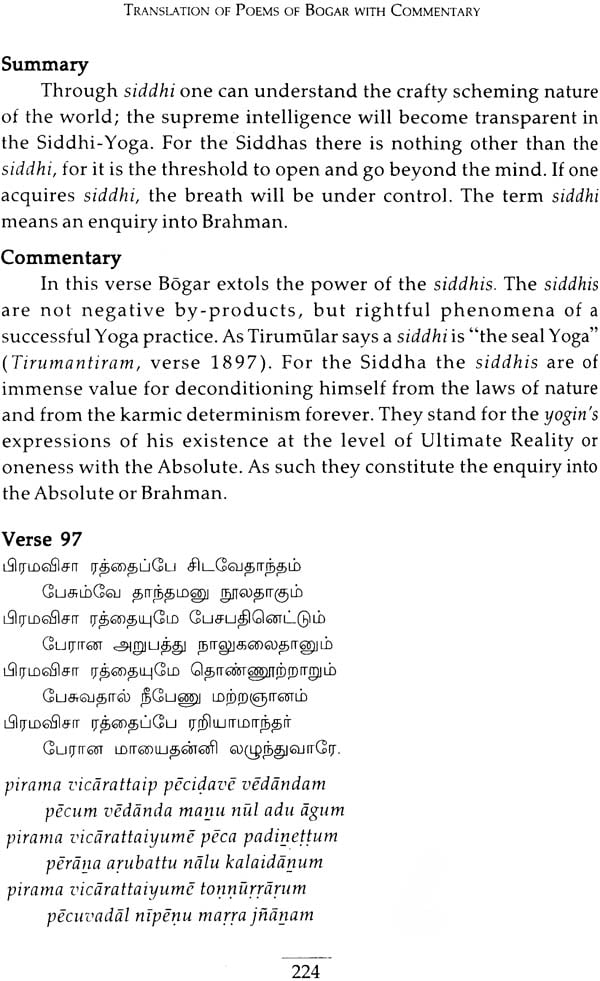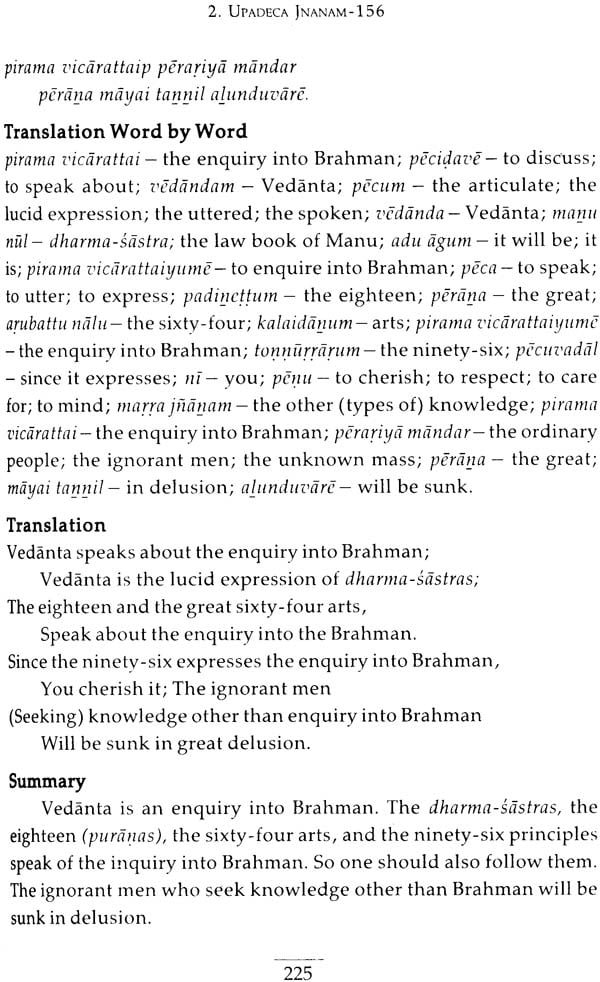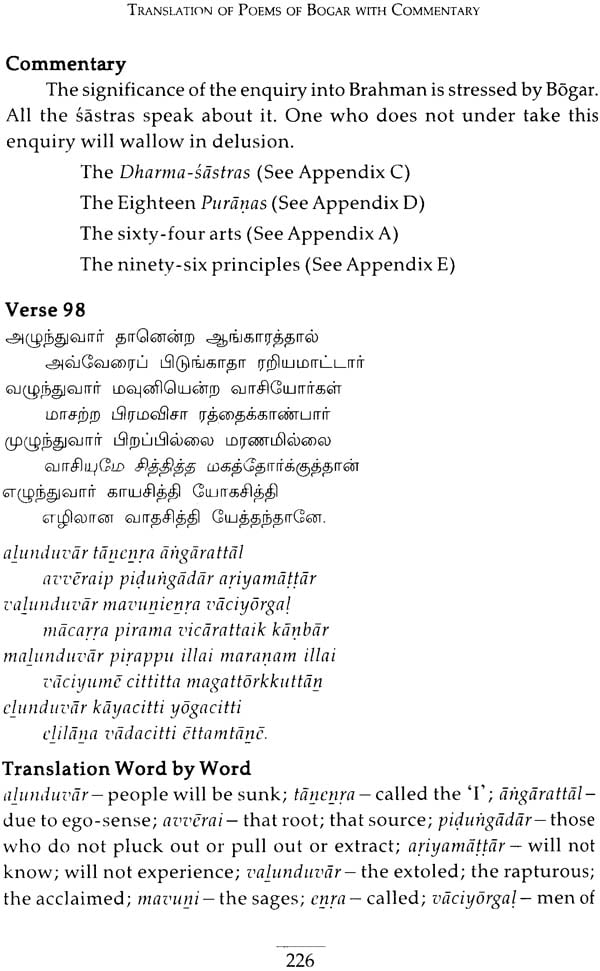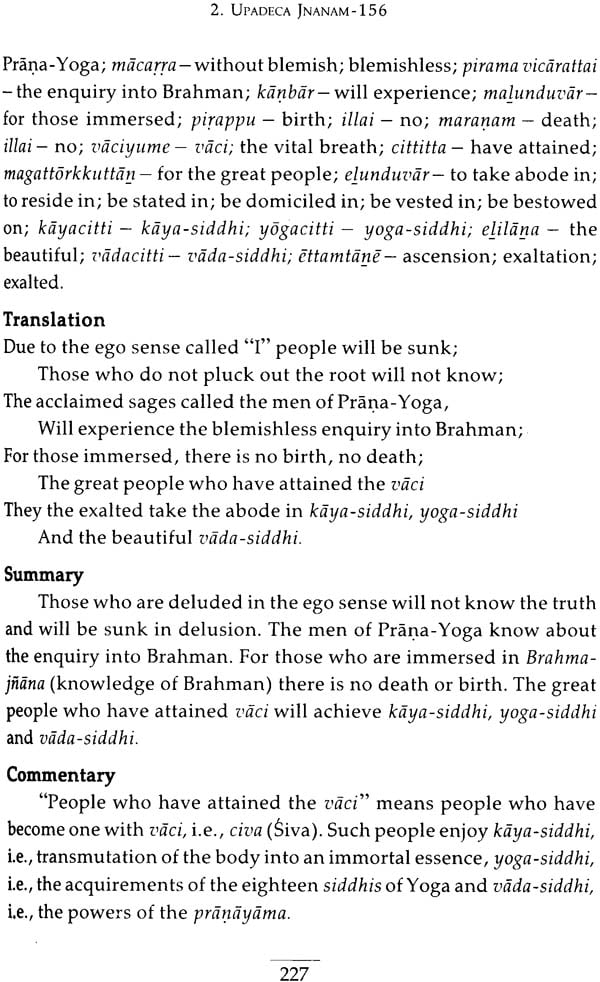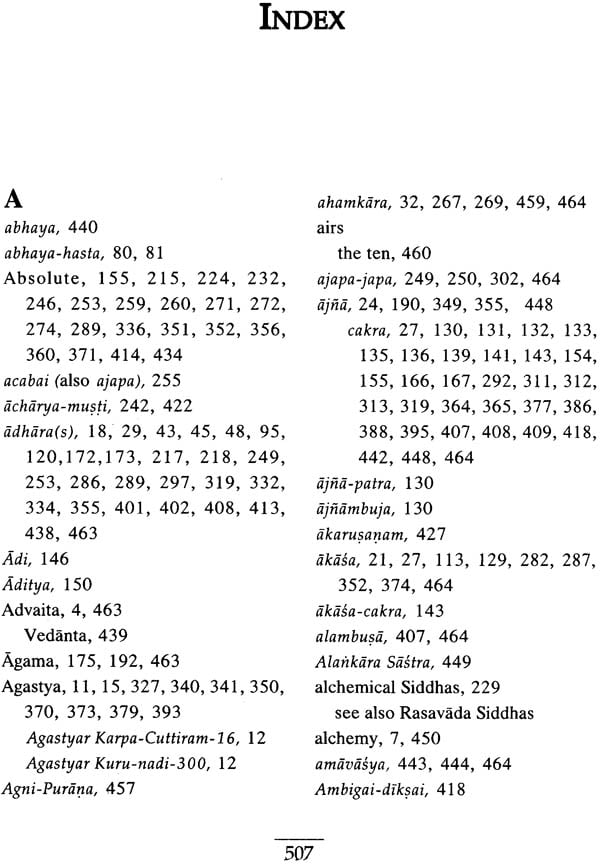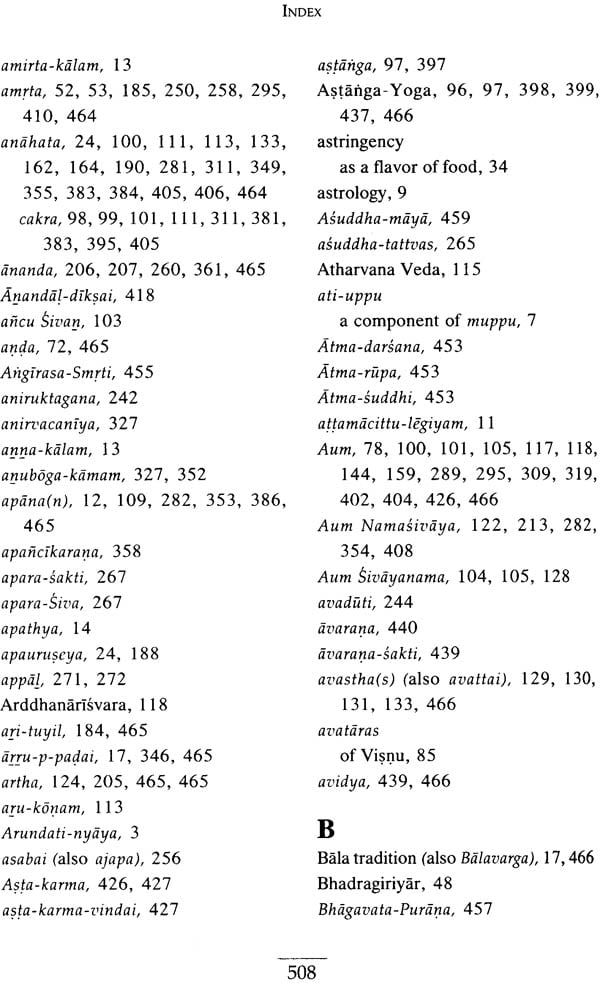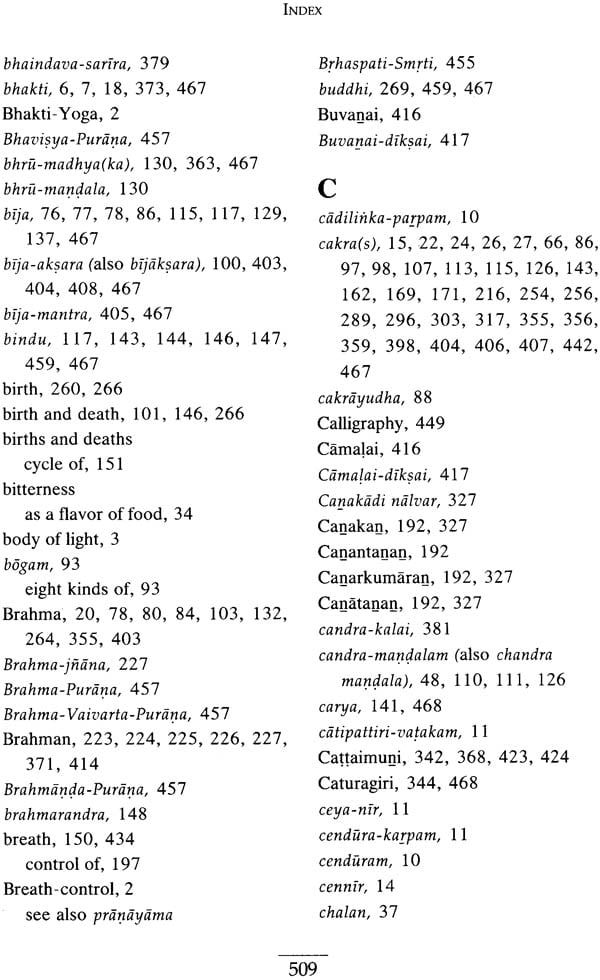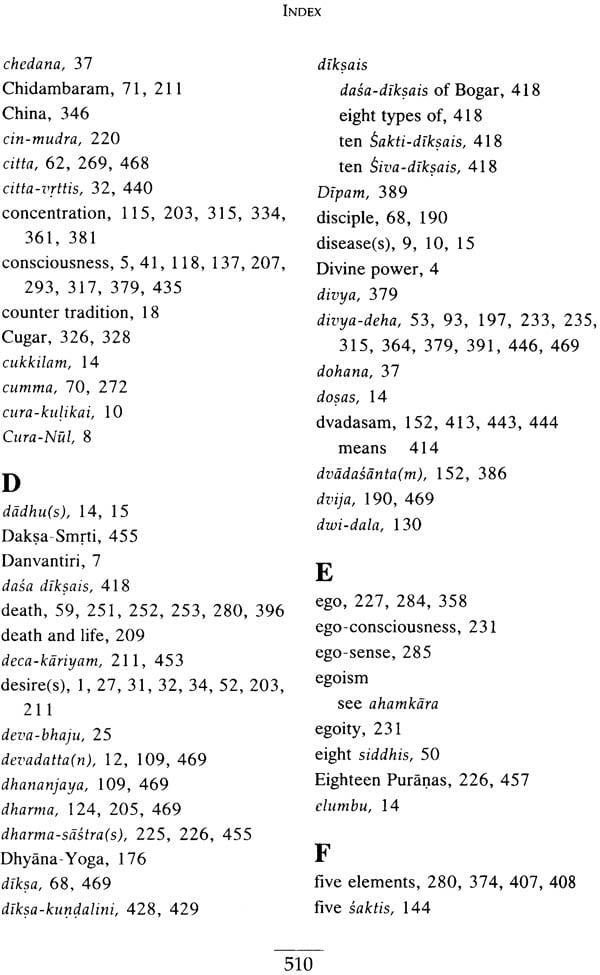
The Yoga of Siddha Boganathar (Volume 2)
Book Specification
| Item Code: | IHL681 |
| Author: | T.N. Ganapathy |
| Publisher: | Babaji’s Kriya Yoga Trust |
| Language: | English |
| Edition: | 2004 |
| ISBN: | 9781895383263 |
| Pages: | 538 ( 6 Color Illustrations) |
| Cover: | Paperback |
| Other Details | 9.0 Inch X 6.0 Inch |
| Weight | 830 gm |
Book Description
The yoga of Siddha Boganathar Volume 2 by T.N. Ganapathy is the second in a series of publication produced by the yoga Siddha Research center sponsored by Babaji’s Kriya Yoga Order of Acharyas and the yoga research and education Center.
Boganathar was the Siddha guru of Kriya Babaji Nagaraj the famed Himalayan Master.
This volume 2 takes us further into the title known world of the who for millennia have explored the furthest reaches of human potentiality and spiritual development. Boganathar was not only one of the greatest adepts of Yoga of all time but also a great scientist.
The author has rendered a great service to all lovers of spirituality and science in the present work. For the first time ever the writings of Boganathar the greatest Scientist of the Siddha tradition have been translated into English and a useful commentary on these profound and difficult texts has been rendered. The present volume contains poems that all lovers of Kundalini Yoga and Tantra will find inspiring.
By contemplating the poems of this present volume the cit-sakti or consciousness energy of Boganathar may be absorbed and the reader will enter a higher state of consciousness. This subtle process referred to as svadhyaya or self study by Patanjali in Sutra 2:1 of the Yoga Sutras is an important part of the sadhana of every student of Kriya Yoga and Tantra.
The heart of this volume is a translation with commentary of two Tamil works of Boganathar. In these works he teaches all about the importance of pranayama, the various chakras Kundalini Yoga the thirty six principles of nature the esoteric three empty spaces and many other fascinating topics related to the little known Siddha tradition. The spiritual path advocated herein by the Siddhas is life affirming non-sectarian and scientific. It inspires us to realize our highest potential.
Born in the Village of Tandankurai in Thanjavur District Tamil Nadu int eh year 1932 and after acquiring his doctorate degree from the Nagpur University in the year 1972 Prof. T.N. Ganapathy retired as Professor and Chairman of the Department of Philosophy Ramakrishna Mission Vivekananda College, Chennai, after thirty nine years of distinguished service as a teacher of philosophy. He has studied the works of the Siddhas since 1975. He was awarded the Senior Fellowship by the Indian Council of philosophical Research New Delhi for three years 1985-1988. His work fir this project on the Philosophy of the Tamil Siddhas was published in the year 1993. Acknowledged as a specialist in Tamil Siddha Philosophy he is at present the Director of the Yoga Siddha Research Center at Chennai India co-sponsored by the Babaji’s Kriya Yoga Order of Acharyas, Inc. Canada and the Yoga Research and education center in California. For this project he has translated the Yoga works of Bogar into English edited the publication of the Yoga of the Eighteen Siddhas: An Anthology the Yoga of Siddha Avvai and is currently preparing a translation commentary and essays on the Tirmandiram.
The Yoga of Siddha Boganathar Volume 2 by Dr. T.N. Ganapathy takes us further into the little known world of the Siddhas adepts of Yoga who for millennia have explored the furthest reaches of human potentiality and spiritual development. Boganathar was not only one of the greatest adepts of Yoga of all time but also a great scientist. In our present scientific age the study of his works is especially rewarding. For the part 500 years our western civilization has suffered from a schism between the rational scientific view of life and the spiritual or religious view. The divide creates in the politically charges period of the Reformation still haunts us. So it is instructive to see in both the life of Boganathar recorded in volume 1 and the writings on Yoga in Volume 2 how one great man synthesized the two views.
Dr. T. N. Ganapathy has rendered a great service to all lovers of spirituality and science in the present work. For the first time ever the writings of Boganathar the greatest scientist of the Siddha tradition have been translated into English and a useful commentary on these profound and difficult texts has been rendered. The present volume contains poems which all lovers of Kundalini Yoga and Tantra will find inspiring.
By contemplating the poems of this present’s volume the cit-sakti or consciousness energy of Boganathar may be absorbed and the reader will enter a higher state of consciousness. This subtle process referred to as svadhyaya or self study by Patanjali in Sutra 2.1 of his yoga-Sutras is an important part of the Sadhana of every student of Kriya Yoga and Tantra. While the poems have many layers of meaning and such meanings can provide much useful guidance to the practitioner it is this process of self realization and transformation which is most important in the contemplation of the works of the siddhas life Boganathar. For this reason one should not read these poems as one would read an ordinary poem. After invoking Boganathar by name with reverence one should first repeat the words of the poems in the original language of Tamil. By so doing one may enter intot he spirit of the work and communion with the author. Then one should review the meaning of each word then the literal translation then the summary translation and finally the commentary. Afterwards one should meditate on the poem and if initiated into Babaji’s Kriya Yoga one may receive intuitively its hidden meaning. Each poem is like a key an like a key it must be turned carefully in a lock to allow one to enter into a new space, where the hidden meaning is reveled. Other wise the poem will remain as ink or paper just as a key is a useless piece of metal if unused. The Siddhas like Boganathar would typically meditate for up to one year before writing a poem and the poem would serve as a point of departure for the disciple to contemplate leading to all that the Siddha were revealed only to the most sincere persons who were prepared to purify themselves by Yogic Sadhana self study and devotion to the lord.
Dr. T. N. Ganapathy has so applied himself and as a result he has been able to a large extent able to decipher the meaning of the poems of Boganathar. It has been a joy for myself and my wife, Durga to assist him in this process and to contribute to the commentaries herein. It has been a process of discovery and I invite the reader to continue it.
I recommend this work to all practitioners of Yoga and Tantra and to all who are seeking for an example of how the science and spirituality can combine.
This work the Yoga of Siddha Boganathar is the Second Volume of the Yoga Siddha Research Center, Chennai. In this volume the following two works of Bogar as mentioned in the volume 1 are translated with the Tamil poem its transliteration worn by word translation, summary and commentary of each of the poems. The two Tamil works of Bogar are taken from Yogi S.A.A. Ramaiah’s five volumes of Bogar Kanda Yogam.
in the introduction to this volume I have explained (1) What Yoga in General Stands for with Special reference of Kriya Yoga (2) The Other features of Siddha doctrines and (3) A Brief note on the above two works of Bogar
All the 156 verses of Upadeva Jnanam have been translated and commented upon while only 45 Yoga verses have been translated form Jnana-Caramcam-100 since the other verses deal with medicine and alchemy.
In translating the verses I have remained true to the original. Yet I know that every translation is an interpretation. There are occasions when some verses refused to be translated because of the intricacies of Yoga involved in them. On such occasions I have closed the book and went to bed concentrating on the difficult verses. Suddenly at the dead of night there will be a flash in my mind as to the significance of the verse which I noted then and there with a pen and notebook kept by the side of the bed. In this connection I would like to narrate an incident in my life. As early as 1980 when I started planning to work on the siddhas I was a little bit diffident and hesitant. One day in the middle of the night I woke up from my sleep my eyes were wide open and my mouth too my body could not move. Suddenly I felt a presence and I felt in my mouth the taste of sacred ash. I was fully aware but motionless. This I understood as a sanction given by the Siddhas to proceed with my work. From that day till today I have been concentrating only on Siddhas and their philosophy. This is a felt experience which cannot be explained further as it is unique and an incomparable experience. People who have the will to believe may believe it otherwise not. But what I experienced can neither be proved nor denied but only indicated.
In this connection one of my friends warned me in good faith not to enter into the field of the Siddhas without getting training under a proper guru. Bearing his advice in my mind I searched for a proper guru. But I was disappointed in finding a guru who can initiate me into the Siddha thoughts and their paradoxical expressions and their explanations. In 2000 when I began the work of the Siddha Yoga Research Project I received the blessings of Boganathar whose direct disciple in Babaji Nagaraj who commissioned the project through the sponsors. I felt a subtle influence guiding me in the writing of the translations and commentaries of the poems. Difficult verses revealed their meaning to me through inspiration. In this way I believe that I was initiated by the Siddhas into the meaning of the poems. How fortunate I am! My acknowledgements are due first of all to the Siddhas and especially to Bogar who are he source for the appearance of this volume and the earlier volume. I acknowledge my gratitude to Sri Govindan Satchitananada and to Sri Gerog Feuerstein who are the sponsors of the Yoga Siddha Research Center. Sri Govindan Satchtananda and Durga Ahlund deserve a special mention. They have gone through my translations and commentaries with their Yogic spectacles and have enriched them by appropriately elucidating and substantiating with their yogic experiences. Sri Neelakantan deserves my special thanks for being a coordinator between me and the sponsors. I express my sincere thanks to Dr. Kr. Arumugam the deputy director of the project work who has helped me through thick and thin. My special thanks are due to Sri G. Uthriadam the manuscriptologist of the center. My grateful thanks are due to my family members who made me scot free from the responsibilities of running a family with care and dedication. To Dr. T.B. Siddhalingaiah my special thanks go for his transliteration work. My special thanks are due to my fried and former colleague, Prof. Dr. Ramesh Babu Dept. of Library Science University of Madras who has help me to obtain the services of his old student Sri M. Tamizhchelvan librarian Indian express group in preparing scientifially the Index of this work.
| Foreword | v | |
| Preface | ix | |
| Notes of Translation | xiii | |
| Guide to Pronunciation in Tamil | xv | |
| Chapter 1 | Introduction | 1 |
| Chapter 2 | Translation of Poems of Bogar with Commentary Upadeca-Jnanam-156 | 19 |
| Chapter 3 | Selections from Jnana Caramcam-100 | 347 |
| Appendix A | The Sixty Four Arts and Sciences | 449 |
| Appendix B | Daca-Kariyam | 453 |
| Appendix C | The Dharma Sastras | 455 |
| Appendix D | The Eighteen Puranas | 457 |
| Appendix E | The Ninety Six Principles | 459 |
| Appendix F | The Thirty Six Tativas | 461 |
| Glossary | 463 | |
| Bibliography | 491 | |
| Index | 507 | |
| About the Author | 523 |
